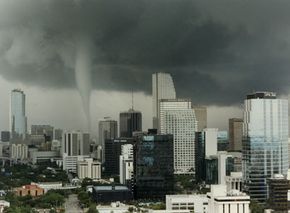The Nature of the Beast: Tornado Basics
To hunt tornadoes, you need to understand them. A tornado is a swirling mass of air that can reach wind speeds above 300 mph. It's spawned from severe thunderstorms with enough energy and the proper conditions to start a "cyclone" of spinning air. Tornadoes can happen anywhere and at any time, but they tend to happen most frequently in the late evening or during the night, when thunderstorms sweeping across the land have picked up energy from the heat of the day. Tornadoes are most commonly encountered in North America, in a huge area ranging from the Rocky Mountains east to the Atlantic Ocean, and from Mexico into Canada. Ohio, Illinois, Missouri, Kansas, Nebraska, Arkansas, Kentucky, Alabama, Oklahoma and Texas are known for tornadoes, but devastating tornadoes have hit Florida, Pennsylvania and other states.
A tornado can be accompanied by frequent lightning, straight-line winds, heavy rain and hail. All these factors add to the danger of a tornado. The tornado itself causes injury and death in three ways:
Advertisement
- Picking people up and hurling them through the air
- Crushing people beneath debris
- Impaling people with objects flung through the air with incredible force
Despite decades of research, we still don't fully understand tornadoes. No one is sure what causes some storms to produce them while other storms don't, or why a few storms produce massive outbreaks of dozens of tornadoes. We do know that they form inside supercells, huge storm clouds that reach up to the stratosphere (an altitude of six miles). Within a supercell, massive quantities of air flow in an updraft. If the horizontal air movement within the supercell is flowing in different directions (wind shear), this could create a spinning effect, known as a mesocyclone. The updraft tilts the mesocyclone so that it is upright, which then allows the updraft itself to start spinning. All the energy within the storm begins to fuel this cyclone. If it touches the ground, it can cause tremendous damage.
Next, we'll check out a day in the life of the people who drive around chasing these dangerous, unpredictable storms.
